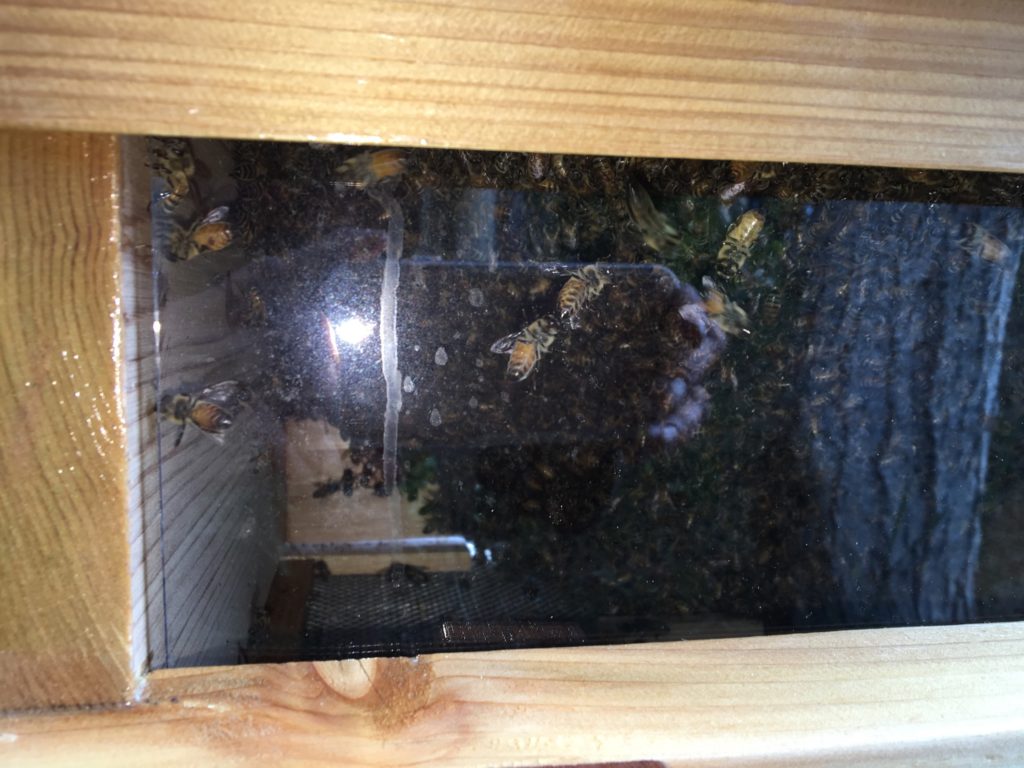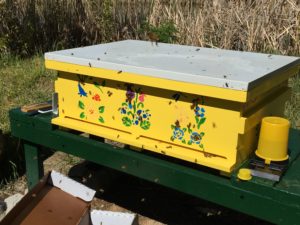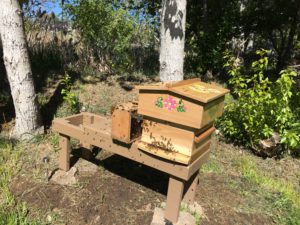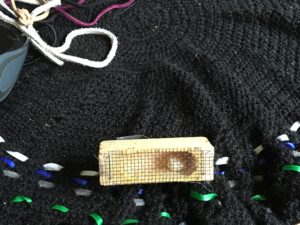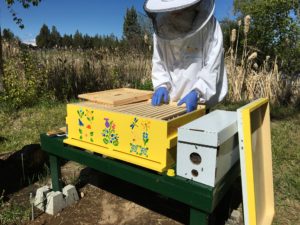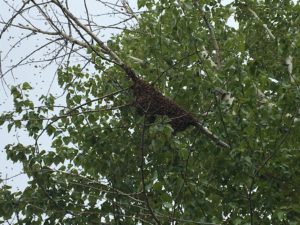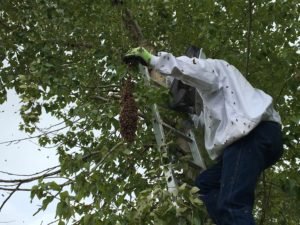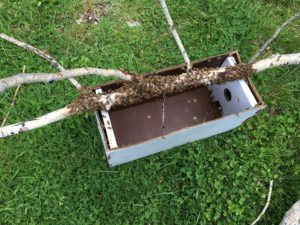New Life in the Apiary and the Unexpected Swarm
Two new hives went into the apiary this year along with two new colonies of bees. We purchased a five-frame nuc for the long hive and a package for the Warre’. The long hive combines the rectangular shape of a top bar hive with the traditional Langstroth design allowing for a nuc to be easily installed.
The Warre’ is a little different, however. Smaller in size, it’s customary to buy a package and dump them inside the box. The queen is in a cage, rather than on one of the frames as with the nuc. The nuc is essentially an established colony, with brood, honey, pollen, and drawn comb on plastic frames. The package of bees must first accept the queen and then begin building their comb for the queen to lay her eggs. She’s already taken her maiden flight for mating purposes at this point and she needs a place to begin laying. For this hive, I chose foundationless frames so that I could see them do their own thing instead of attaching to plastic foundation. This particular Warre’ hive has an inspection window to check out how the comb building is doing. The picture above was at the end of their first day in their new home.
After dumping the bees into the Warre’ box, I located the queen cage and dug out the cork plug to insert a small marshmallow. I placed the queen back in on the bottom of the hive. You can release the queen directly, but this way, they have to work to get to her, increasing the chance that she’ll be accepted. Odds are, however, that process has already taken place while in the package.
Next, we installed the five-frame nuc in the new long hive. We divided the hive in half and used only one end, putting the nuc frames in the middle of that section of the hive. It’s the same idea as having two Langstroth style hive boxes side by side, but with the ability to have the whole box function as one big hive. It’s like a horizontal top bar hive in that regard, but not V-shaped. The honey tends to be at each end with the brood in the middle in a horizontal hive and I also purchased foundationless frames for this hive as well. After a couple of days, I went back in and alternated a foundationless frame with a nuc frame so that they could begin to build their own comb. The comb in the nuc was a little darker than I would have liked to see, but it is what it is.
I began writing this post before I went outside to work in the garden. I took a break and while outside, I heard the most intense buzzing sound. At first, I thought the bees had found the hawthorn blossoms. But when I walked over by the apiary, I saw bees everywhere above the hives, in a slight funnel shape. I immediately found my husband and we donned our bee suits. One of the hives had swarmed into a tree above. Cool!
Well, not really cool as much as get the ladder. At least they only went up a few feet. It was our first swarm so we winged it. Jerry got the nuc boxes we have and I got all the pruners I could find. Sometimes you have to prune as you go and you might have to cut the branch they’re on. The bees swarm around the queen, and when they do that, they’re somewhat docile. And it really was cool watching them build their clump. Which they had to do a couple of times because we made several attempts before we got them in the box. Sometimes they drop right off of the branch and fall to the ground as a unit. At least they landed in the cattails. Jerry had to hold the limb there and let them swarm back up and reattach before climbing down with the swarm.
We discovered right away that if we didn’t put the plug back in the box, the bees would fly out and re-swarm in the same tree. At one point, they began bearding all over one of the hives. I brushed some of them back into the box and closed the lid. No ladder involved this time.
The rumor is, if they swarm once, they’ll do it again. So we drove up to the farm store that carries beekeeping supplies and bought two more boxes with frames. We’d used the last of the extra boxes when we expanded and split the original hive, but evidently the bees had other ideas and swarmed anyway. It’s swarm season after all and it seems like a bunch of folks are experiencing this, many for the first time. So as long as they stay close by, it’s easy to bring them back, but if they travel, then you’re following your bees around the neighborhood until they decide to stop in a tree somewhere.
Swarms happen even if you do everything right. And the thing is, a swarm isn’t dangerous. They’re swarming around their queen, protecting her, so they’re busy and unconcerned with people around them. So you don’t have to run screaming for the hills. Instead, call 911 and tell them you’ve found a swarm. They’ll contact the local beekeeping association and someone will come and get the bees. If they don’t know who owns the bees, then the swarm catcher will get some free bees if he or she wants them. Otherwise, there’s typically a list that beekeepers put their names on to receive swarm bees. And it certainly beats buying them.
I hope the bees we collected in the nuc box will go back to their hive on their own, but time will tell. I guess we’ll be on swarm watch for the next month or so. Fun times. Stay tuned.
If anyone intends to either quote something I've written, or intends to post any part of my work, including my videos, on any other site, please ask permission before doing so. Any reposting of my work without permission can be considered as copyright infringement, so please ask. And if I give permission, you MUST clearly reference my name as author and my website. No exceptions. The words an author writes are sacred. Unapproved use is not.
Thank you... Jan Erickson

